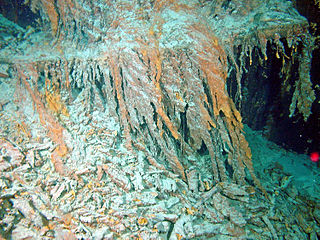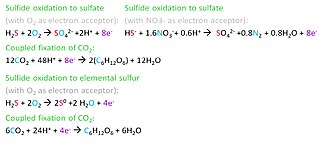
Thiomargarita namibiensis is a harmless, gram-negative, facultative anaerobic, coccoid bacterium found in the ocean sediments of the continental shelf of Namibia. The genus name Thiomargarita means "sulfur pearl." This refers to the appearance of the cells as they contain microscopic sulfur granules that scatter incident light, lending the cell a pearly luster. This causes the cells to form chains, resembling strings of pearls. The species name namibiensis means "of Namibia", which is an ode to their country of discovery and existence. Together, Thiomargarita namibiensis means “Sulfur pearl of Namibia".
The Aquificota phylum is a diverse collection of bacteria that live in harsh environmental settings. The name Aquificota was given to this phylum based on an early genus identified within this group, Aquifex, which is able to produce water by oxidizing hydrogen. They have been found in springs, pools, and oceans. They are autotrophs, and are the primary carbon fixers in their environments. These bacteria are Gram-negative, non-spore-forming rods. They are true bacteria as opposed to the other inhabitants of extreme environments, the Archaea.
The Thermotogota are a phylum of the domain Bacteria. The phylum contains a single class, Thermotogae. The phylum Thermotogota is composed of Gram-negative staining, anaerobic, and mostly thermophilic and hyperthermophilic bacteria.
Aquifex pyrophilus is a gram-negative, non-spore forming, rod-shaped bacteria. It is one of a handful of species in the Aquificota phylum, which are a group of thermophilic bacteria that are found near underwater volcanoes or hot springs.

Sulfur-reducing bacteria are microorganisms able to reduce elemental sulfur (S0) to hydrogen sulfide (H2S). These microbes use inorganic sulfur compounds as electron acceptors to sustain several activities such as respiration, conserving energy and growth, in absence of oxygen. The final product of these processes, sulfide, has a considerable influence on the chemistry of the environment and, in addition, is used as electron donor for a large variety of microbial metabolisms. Several types of bacteria and many non-methanogenic archaea can reduce sulfur. Microbial sulfur reduction was already shown in early studies, which highlighted the first proof of S0 reduction in a vibrioid bacterium from mud, with sulfur as electron acceptor and H
2 as electron donor. The first pure cultured species of sulfur-reducing bacteria, Desulfuromonas acetoxidans, was discovered in 1976 and described by Pfennig Norbert and Biebel Hanno as an anaerobic sulfur-reducing and acetate-oxidizing bacterium, not able to reduce sulfate. Only few taxa are true sulfur-reducing bacteria, using sulfur reduction as the only or main catabolic reaction. Normally, they couple this reaction with the oxidation of acetate, succinate or other organic compounds. In general, sulfate-reducing bacteria are able to use both sulfate and elemental sulfur as electron acceptors. Thanks to its abundancy and thermodynamic stability, sulfate is the most studied electron acceptor for anaerobic respiration that involves sulfur compounds. Elemental sulfur, however, is very abundant and important, especially in deep-sea hydrothermal vents, hot springs and other extreme environments, making its isolation more difficult. Some bacteria – such as Proteus, Campylobacter, Pseudomonas and Salmonella – have the ability to reduce sulfur, but can also use oxygen and other terminal electron acceptors.

Thermotoga is a genus of the phylum Thermotogota. Members of Thermotoga are hyperthermophilic bacteria whose cell is wrapped in a unique sheath-like outer membrane, called a "toga".

Shewanella is the sole genus included in the marine bacteria family Shewanellaceae. Some species within it were formerly classed as Alteromonas. Shewanella consists of facultatively anaerobic Gram-negative rods, most of which are found in extreme aquatic habitats where the temperature is very low and the pressure is very high. Shewanella bacteria are a normal component of the surface flora of fish and are implicated in fish spoilage. Shewanella chilikensis, a species of the genus Shewanella commonly found in the marine sponges of Saint Martin's Island of the Bay of Bengal, Bangladesh.
Pyrobaculum is a genus of the Thermoproteaceae.

Halomonas titanicae is a gram-negative, halophilic species of bacteria which was isolated in 2010 from rusticles recovered from the wreck of the RMS Titanic. It has been estimated by Henrietta Mann, one of the researchers that first isolated it, that the action of microbes like Halomonas titanicae may bring about the total deterioration of the Titanic by 2030. While the bacteria have been identified as a potential danger to oil rigs and other man-made objects in the deep sea, they also have the potential to be used in bioremediation to accelerate the decomposition of shipwrecks littering the ocean floor.
Thermococcus kodakarensis is a species of thermophilic archaea. The type strain T. kodakarensis KOD1 is one of the best-studied members of the genus.

Thermotoga maritima is a hyperthermophilic, anaerobic organism that is a member of the order Thermotogales. T. maritima is well known for its ability to produce hydrogen (clean energy) and it is the only fermentative bacterium that has been shown to produce Hydrogen more than the Thauer limit (>4 mol H2 /mol glucose). It employs [FeFe]-hydrogenases to produce hydrogen gas (H2) by fermenting many different types of carbohydrates.
Desulfobulbus propionicus is a Gram-negative, anaerobic chemoorganotroph. Three separate strains have been identified: 1pr3T, 2pr4, and 3pr10. It is also the first pure culture example of successful disproportionation of elemental sulfur to sulfate and sulfide. Desulfobulbus propionicus has the potential to produce free energy and chemical products.
Thermotoga neapolitana is a hyperthermophilic organism that is a member of the order Thermotogales.
Thermotoga hypogea is a hyperthermophilic organism that is a member of the order Thermotogales. It is thermophilic, xylanolytic, glucose-fermenting, strictly anaerobic and rod-shaped. The type strain of T. hypogea is SEBR 7054.
Acidithiobacillus caldus formerly belonged to the genus Thiobacillus prior to 2000, when it was reclassified along with a number of other bacterial species into one of three new genera that better categorize sulfur-oxidizing acidophiles. As a member of the Gammaproteobacteria class of Pseudomonadota, A. caldus may be identified as a Gram-negative bacterium that is frequently found in pairs. Considered to be one of the most common microbes involved in biomining, it is capable of oxidizing reduced inorganic sulfur compounds (RISCs) that form during the breakdown of sulfide minerals. The meaning of the prefix acidi- in the name Acidithiobacillus comes from the Latin word acidus, signifying that members of this genus love a sour, acidic environment. Thio is derived from the Greek word thios and describes the use of sulfur as an energy source, and bacillus describes the shape of these microorganisms, which are small rods. The species name, caldus, is derived from the Latin word for warm or hot, denoting this species' love of a warm environment.
Thermotoga elfii is a rod-shaped, glucose-fermenting bacterium. The type strain of T. elfii is SEBR 6459T. The genus Thermotoga was originally thought to be strictly found surrounding submarine hydrothermal vents, but this organism was subsequently isolated in African oil wells in 1995. A protective outer sheath allows this microbe to be thermophilic. This organism cannot function in the presence of oxygen making it strictly anaerobic. Some research proposes that the thiosulfate-reducing qualities in this organism could lead to decreased bio-corrosion in oil equipment in industrial settings.
Thermotoga petrophila is a hyperthermophilic, anaerobic, non-spore-forming, rod-shaped, fermentative heterotroph, with type strain RKU-1T. T. petrophila was first discovered and isolated from an oil reservoir off of the coast of Japan and was deemed genetically distinct from its sister clades. Because these organism are found in deep, hot aquatic settings, they have become of great interest for biotechnology due to their enzymes functioning at high temperatures and pressures.

Microbial oxidation of sulfur is the oxidation of sulfur by microorganisms to build their structural components. The oxidation of inorganic compounds is the strategy primarily used by chemolithotrophic microorganisms to obtain energy to survive, grow and reproduce. Some inorganic forms of reduced sulfur, mainly sulfide (H2S/HS−) and elemental sulfur (S0), can be oxidized by chemolithotrophic sulfur-oxidizing prokaryotes, usually coupled to the reduction of oxygen (O2) or nitrate (NO3−). Anaerobic sulfur oxidizers include photolithoautotrophs that obtain their energy from sunlight, hydrogen from sulfide, and carbon from carbon dioxide (CO2).
Thiodictyon is a genus of gram-negative bacterium classified within purple sulfur bacteria (PSB).
Fusibacter is a genus of bacteria within the phylum Bacillota. Species are most well known from technical environments, Fusibacter fontis being the first described species of this genus isolated from a natural environment. The reported members of this genus are fermentative and halotolerant anaerobes. Moreover, these species share sulfur-reducing features capable of generating sulfide starting from elemental sulfur or thiosulfate sources.






